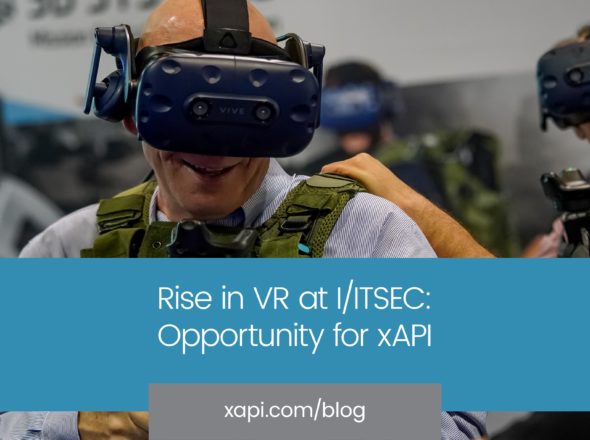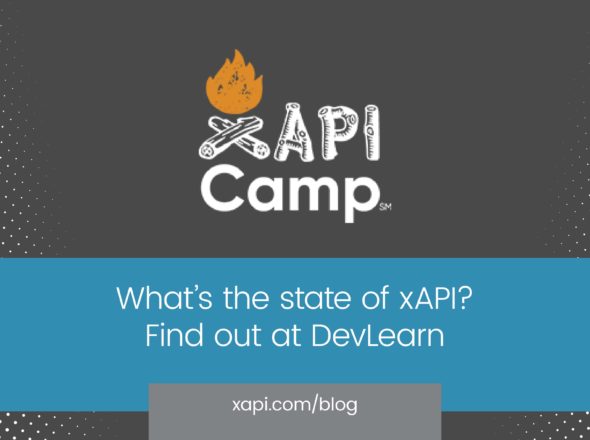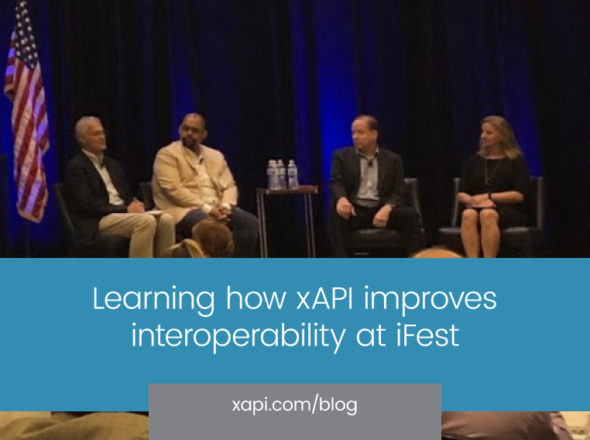Yesterday, I hosted a webinar entitled “Rethinking Learning Systems with the Experience API”. The attendees had more questions that we could answer during the live webinar, so I’ve posted your questions and my answers here.
Q: What is TDS?
A: TDS = Training Delivery System. A new product category with the responsibility to deliver and track learning and training content. Tracking is handled by the Experience API. Think of is as an independent SCORM player that can handle pushing out formal structured training that can be launched from anywhere.
Q: So only “approved” verbs can be used in the I “did” this – and who approves them?
Q: Is there a standardized set of verbs that map to SCORM values?
A: xAPI allows statement creators to define their own verbs, they are not limited to a standard predefined set. Defining a new very shouldn’t be done casually however. Statement creators should try to reuse existing verbs whenever possible to maximize interoperability and the ability for others systems to understand the meaning of the statement. ADL has produced a standard set of verbs that cover the initial basic use cases of xAPI, including everything needed to describe the traditional activity in SCORM courses. There are also several registries in the works that provide a common place for people to share and curate definitions of new verbs.
Q: OK – the API is I DID THIS – so if I finish, for example, an instructor led class – don’t I need some interface (an APP on my phone) to get this to my PDL or LRS?
Q: Could xAPI be used with interactive television to record that I watched something?
Q: How does a YouTube view get to the lrs ?
Q: I noticed I Facebook does not interface with bookmarklet ..what access restrictions does xAPI face?
Q: What are a few examples of how “Classroom Events” can be tracked via the Experience API?
A: xAPI requires that some statement creator be present and that statement creator has sufficient access and knowledge to garner enough information about the learning experience. xAPI certainly doesn’t guarantee any kind of system access, nor does it somehow magically know about a person’s learning experiences. xAPI is simply a conduit by which something that knows about a learning experience can record that learning experience. So, to answer the specific questions:
-
Yes, xAPI needs some kind of interface or app to get the information about attendance in an instructor led class into your PDL or LRS. This app could require manual entry on the part of the student, or it could be a pre-existing classroom attendance application that simply make statements about information it already has.
-
Yes, an interactive TV could make statements about what you choose to watch
-
A statement about watching a YouTube video could get into the LRS in a number of ways. Most likely, the learner would self-report it via a bookmarklet or similar tool, but one can also imagine a more structured environment that uses the YouTube API to monitor specific views in a controlled environments.
-
If Facebook does not interface well with the bookmarklet, that is restriction of the bookmarklet. Perhaps a more sophisticated bookmarklet is needed (the current one was just a proof of concept), or perhaps a completely different type of tool is needed to capture data about interactions with social networks.
-
Check out these reads about collecting data in a classroom:
Q: Is xAPI the same as the Experience API?
Q: It is Experience API or Experience API?
Q: Will “TinCan” be sunset since the official name is “Experience API” ?? 😉
A: Yes, the Experience API is the same as the Experience API. Experience API is the formal name from ADL, but just about everybody calls it the the Experience API. We don’t see any benefit to swimming against the current so we call it the Experience API. More info at ../2012/12/11/we-call-it-tin-can/.
Q: What is a PDL again?
Q: Who has access to the personal data locker – you manages it – only the learner – no one else
A: PDL stands for Personal Data Locker. The learner is the only one with direct access to their PDL. Conceptually, the learner will then be able to share (segments of) their learning records with any trusted LRS. The learner will be in control. But all of this is still conceptual, the concepts of a PDL are now technically possible, but there are big challenges to making one that is ready for widespread use.
Q: I think ownership of training data is a different question from sharing that data. The employee who provides the training owns the training record. They may, or may not, choose to share that data.
A: Good point.
Q: Does the Experience API have any sharing _requirements_ built into it? Or could it be used to share only among “trusted” consumers?
A: xAPI allows for LRSs to decide which trusted consumers have permissions to see which sets of data. Permissions and data management is a core required function of an LRS. There is a big open question in the development of Experience API conformance requirements concerning how we will validate that an LRS is both sufficiently open and sufficiently secure.
Q: What is the consistent identifier that lets multiple LMS, HR, Different companies know who the Learner is? One company may have Employee ID, Somewhere else may have e-mail, Somewhere else may use Name and Birthday
A: Good question. xAPI allows for individuals to be identified in different ways. It is a core function of the LRS to merge multiple personas to consolidate records for a particular learner. This points makes another good case for a personal data locker where you are in control of managing your identity and controlling access to different segments of your learning records, perhaps based on which of your “personas” generated the statement.
Q: Can personally identifying data be scrubbed or restricted when sharing?
A: Good question. Conceptually yes. The hardcore xAPI geeks will point out that statements are immutable. That means that once a statement is made, it can’t be changed in any way (i.e., you can’t just remove the PII from that statement). However a LRS could choose to transmit a set of scrubbed statements be generating a new set of statements representing the scrubbed data.
Q: It would also be helpful to answer some opposition questions like: If the user is doing all of the input, who is validating that what they did was actually done. How do you prevent clutter/chaos of someone who wants to track everything. How is the data captured/sorted so that a report can be run on it. Can you delete data that is bad?
Q: Theoretical Question: How is the integrity of the LRS maintained. If learning records start to be collected in Personal Data Lockers, what kinds of discussions have you been having around the integrity of those PDLs? AS in, ensuring that people aren’t fudging their learning instances?
A: These are all big open hard questions and some of the reasons why PDLs aren’t quite ready for primetime yet. There will be bad data in self-reported systems. There are big data / AI routes to filtering this data that can be explored, however more immediately I would offer three insights. First, xAPI allows us to securely validate the “asserter” of a statement (who actually made the statement). We can adjust the weight we place on the validity of a statement based on the asserter. Second, self-reporting learning would tend to be informal learning events that shouldn’t be used in high stakes assessment. Third, even with junk in the records, we can get an interesting picture of a learner. A person’s Facebook wall is a similar beast. People’s Facebook walls are very different in their contents and degree of clutter, but when I scan somebody’s wall I can usually get a good feel for who that person is. PDL records can be similarly informative. In fact, the presence of a lot of junk data might present a very informative glimpse into a person’s character and values.
Q: Do I need to learn SCORM before getting started on learning xAPI?
A: You don’t need to know anything about SCORM to get started with xAPI, but xAPI can be used to support SCORM content. If you haven’t been using SCORM, then just jump straight to the new xAPI paradigm.
Q: How entailed is it to create your own LRS? Highly regulated environment would have issue with storing in the “cloud”.
Q: How is the xAPI Data stored? Is it in a database with tables and columns? I know you use JSON to transfer the data but how is it stored?
Q: Do we have any details or Specifications on how to build LRS on own?
Q: What are they using for analytical reporting?
Q: Are there any analytical tool or model or case study for TinCan Data?
A: Creating a LRS is not a trivial affair. We are working on a very high level overview article about what it takes. Subscribe to the newsletter to get that article when it comes out. xAPI data can be stored however the LRS chooses to implement data storage under the hood. There are two approaches to analytical reporting. The first involves piping xAPI data to an existing business intelligence system or reporting tool. The second approach is to use the analytical components of the LRS. Key features of an independent organizational LRS are the ability to transform xAPI data into a format interoperable with business intelligence tools and the ability to provide sophisticated visualization and analysis of potentially unstructured xAPI data. (Demonstrations of these analytical tools would make for a good future webinar). We license our LRS technology for deployment behind the firewall.
Q: Have you planned to make a technically webinar to illustrate how to implement/use xAPI concretely ?
Q: Do you have some technical part? Showing API calls or some kind of data exchange?
A: Check out the “xAPI Technical” webinar here…and check out our Developers’ Section here.
Q: How to know what information needs to be retrieved from LRS to LMS. For example LRSs store lot of information related to someone taking xAPI courses. In that case, how to know what are needed for LMS to show user progress and completion.
A: That would be up to the LMS to determine. LMS vendors have a lot of very big and difficult questions to address in determining how they will best support the Experience API. We could spend another full webinar just enumerating all of the decisions LMS vendors need to make in deciding upon their xAPI adoption strategy.
Q: Mike – could you publish a list of xAPI interfaces that are currently functional i.e. watershed etc… helps developers follow our explanations 🙂
Q: What’s the uptake on LRS integration with the leading LMS vendors?
Q: What do you think how long will it take being accepted TCAPI for most educational institution?
Q: Do you know if Meridian Global has LRS? We are beginning to implement them, and they said they are xAPI compliant, but I don’t see anything with the language of LRS.
A: We publish new adopters of the Experience API that we know about at ../adopters/. Uptake is happening much quicker than we ever expected, but it is still very early. We have had conversations with every major LMS vendor to make them aware of xAPI and its implications. Some (who you can see in the adopters list) have started to adopt xAPI (but as mentioned in the webinar, they are all implementing different adoption strategies). To my knowledge, Meridian does not have an existing xAPI implementation, I would ask them to specifically confirm what is in their implementation. Educational institutions will be interesting to watch. Most of our efforts have been focused on the corporate world, but there are fascinating implications for education and we are eager to see xAPI embraced in that community.
Q: Can data be passed through Firewall, if the LMS is hosted internally?
A: xAPI is a REST API. That means that if basic HTTP traffic can pass through your firewall, then Experience API statements can pass through as well. If the firewall doesn’t allow simple HTTP requests through, then there’s little chance that it is going to allow anything through.
Q: Is the LRS a separate product or is it part of an LMS?
Q: Would the LRS be implemented into an LMS as a plugin?
A: It can be both. There are standalone Learning Record Stores, and some LMSs have tightly integrated LRSs incorporated into them. The LRS was originally conceived as “the part of the LMS that manages xAPI statements”, however standalone LRSs with additional functionality are gaining in popularity.
Q: How is xAPI different from a query language? How is it better/more specialized than SQL, Mongo, or other database systems?
A: You can think of xAPI as storage and retrieval system optimized for learning activity records.
Q: How secure are the LRSs and the PDL’s? Are they vulnerable to exploitation?
A: Both can be very secure, but as with any software, there is no guarantee that developers won’t introduce security vulnerabilities. The Experience API supports both Basic Auth and oAuth for validating user credentials.
Q: How this relates to the Learning Registry? I think It’s crucial to link learning resources data with learner’s data.
A: Absolutely. xAPI includes the ability for statements to reference definitions of learning activities from other sources. The Learning Registry would be a great source of learning activity definitions.
Q: Is there a difference between xAPI Data and Paradata?
A: Yes. xAPI data is about a learner’s experience with a learning activity. Paradata is about how a learning resource is being used to deliver educational experiences. For example, xAPI would say “Joe Learner read an article”, paradata would say that “Teacher Jane used an article in her class”. Both are based on activity streams though for increased compatibility.
Q: Where do the learning objects (resources) reside in this case? LMS or TDS or Learning Object Repository?
A: Learning objects could reside in any of these places. That’s somewhat the point of the webinar, we now have the flexibility to deploy our learning resources however we want to.
Q: I am confused is xAPI the LRS?
A: The Experience API is the standardized plumbing in the background that connects all of these systems to one or more LRSs.
Q: I’m still fuzzy about how user management and curriculum management are implemented. Without an LMS, how are assignments made if that is something that is required?
A: If that is something that is required, then you can certainly still use an LMS. There is nothing stopping that, nor is anybody saying that LMSs are going to go away. They still provide a lot of valuable functionality.
Q: Tracking process is not for monitor people, that process create opportunity for next learning step in their curricula. We have sequencing in SCORM and that creates a personal learning path….I think that is necessary that records from LRS to be managed by an intelligent tutoring systems which also will create a personal learning path based on different kind of content.
A: Absolutely! That is the ideal end state.


